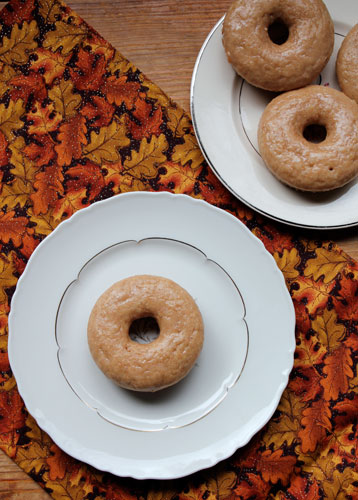If you are not eating leftover pumpkin, apple, or pecan pie this morning for breakfast (full disclosure: I am considering doing the same), consider giving this recipe for apple-cinnamon coffee cake a try. This easy coffee cake offers plenty of flavor without a lot of calories and fat -- the perfect antithesis to yesterday's Thanksgiving feast.
I have a tendency to lower the sugar in most recipes I try. In the case of this coffee cake, I balked at the one cup of granulated sugar the original recipe called for and simply halved the amount. I don't think the flavor suffers at all; to my palate the coffee cake is still plenty sweet, especially since it has a cinnamon-sugar streusel topping.
Apple-Cinnamon Coffee Cake (printer-friendly version)
makes 12 servings
For the cake:
1 1/2 cups whole-wheat pastry flour
1/2 cup granulated sugar
1 1/2 teaspoons aluminum-free baking powder
1 1/2 teaspoons ground cinnamon
1/2 teaspoon fine sea salt
3/4 cup organic skim milk
2 tablespoons unsalted butter, melted
1 teaspoon vanilla extract
1 large egg, lightly beaten
1 cup diced peeled Granny Smith apple (small dice - the apple pieces should be about pea size)
For the streusel topping:
1/4 cup packed brown sugar
1 tablespoon granulated sugar
2 tablespoons whole-wheat pastry flour
1 teaspoon ground cinnamon
1/4 teaspoon ground nutmeg
2 tablespoons unsalted butter, cold and cut into small cubes
1. Preheat the oven to 350 degrees. Lightly grease an 8-inch square baking dish with cooking spray and set aside.
2. In a large bowl, sift together the whole-wheat pastry flour, granulated sugar, baking powder, cinnamon, and sea salt. In a medium bowl, stir together the skim milk, melted butter, vanilla, and egg. Pour the wet ingredients into the dry ingredients and stir to combine. Fold in the diced apple. Spoon the batter into the prepped baking dish.
3. In a small bowl, stir together the sugars, flour, cinnamon, and nutmeg. Cut in the cubed butter with the use of a pastry blender or two forks until the mixture resembles pea-sized crumbles. Carefully spoon the streusel evenly over top the batter.
4. Bake for 40-45 minutes, or until a toothpick inserted into the center of the cake comes out clean. Let the cake cool for 10 minutes on a wire rack before serving.
(adapted from this Cooking Light recipe)
makes 12 servings
For the cake:
1 1/2 cups whole-wheat pastry flour
1/2 cup granulated sugar
1 1/2 teaspoons aluminum-free baking powder
1 1/2 teaspoons ground cinnamon
1/2 teaspoon fine sea salt
3/4 cup organic skim milk
2 tablespoons unsalted butter, melted
1 teaspoon vanilla extract
1 large egg, lightly beaten
1 cup diced peeled Granny Smith apple (small dice - the apple pieces should be about pea size)
For the streusel topping:
1/4 cup packed brown sugar
1 tablespoon granulated sugar
2 tablespoons whole-wheat pastry flour
1 teaspoon ground cinnamon
1/4 teaspoon ground nutmeg
2 tablespoons unsalted butter, cold and cut into small cubes
1. Preheat the oven to 350 degrees. Lightly grease an 8-inch square baking dish with cooking spray and set aside.
2. In a large bowl, sift together the whole-wheat pastry flour, granulated sugar, baking powder, cinnamon, and sea salt. In a medium bowl, stir together the skim milk, melted butter, vanilla, and egg. Pour the wet ingredients into the dry ingredients and stir to combine. Fold in the diced apple. Spoon the batter into the prepped baking dish.
3. In a small bowl, stir together the sugars, flour, cinnamon, and nutmeg. Cut in the cubed butter with the use of a pastry blender or two forks until the mixture resembles pea-sized crumbles. Carefully spoon the streusel evenly over top the batter.
4. Bake for 40-45 minutes, or until a toothpick inserted into the center of the cake comes out clean. Let the cake cool for 10 minutes on a wire rack before serving.
(adapted from this Cooking Light recipe)

























